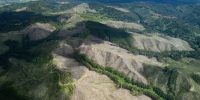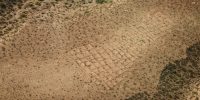

Silverbell Mountains in Ironwood Forest National Monument. The proposed I-11 corridor would be built directly adjacent to Saguaro National Park and Ironwood Forest National Monument, directly affecting wildlife corridors between these protected areas. Photo Credit: Lee Pagni/LightHawk.
What Happened: A proposed 280-mile highway in southern Arizona will cut through ecological wonders of the Sonoran Desert.
Why It Matters: The Sonoran Desert is a unique ecosystem found nowhere else on Earth. This planned I-11 route would fragment important wildlife habitat and alter the character of Saguaro National Park and Ironwood National Monument.
LightHawk Conservation Initiative: Protecting Landscapes
What LightHawk Is Doing: LightHawk flew the Coalition for Sonoran Desert Protection along the entire route of the proposed road, to photograph what we stand to lose if the road is built.
Outcome: Photographer Frank Straub collected high-quality photographs for use in outreach materials and a photo essay to engage the public in preventing this new road.
Meet the LightHawk Staff

Audrey Ek-Psomas
Eastern Program Coordinator & Volunteer Pilot Intake Coordinator
Audrey, our Albuquerque-based staff member, is key in organizing LightHawk’s Eastern conservation missions as well as missions in New Mexico and Colorado.
- She ensures conservation projects on the East Coast, in the Midwest, and in New Mexico and Colorado are well-organized and run smoothly.
- She’s the first point of contact for pilots and partners in those areas.
- She helps partners understand how aviation can help their conservation work.
- She manages the intake process for all incoming volunteer pilots.
Audrey Ek-Psomas, originally from New Mexico, has spent much of her youth living and studying abroad in Europe and South America, which has spurred a love for travel and nature. Before joining the LightHawk team, she was the Training/Project Coordinator for the Center for Protected Area Management (CPAM) at Colorado State University where she provided logistical management for two annual capacity-building courses for professionals working in protected areas, especially from Latin America.
Audrey graduated from Colorado State University with a Master’s of Science in Conservation Leadership, and her master’s thesis focused on the feasibility of involving the local tourism sector in funding management of a nature reserve the Peruvian Amazon. She is a co-author of an article in the Journal of Sustainable Tourism describing those findings.
With an undergraduate degree in political science, Audrey is passionate about interacting with people from diverse cultures and problem-solving to create innovative solutions for the betterment of community and environment. Her professional interests include collaborative conservation, conservation leadership, and social science applications for natural resource issues.
LightHawk in the News
Florida Phoenix: Polluted Waters: Will FL lawmakers insist on tough cleanup measures?
“Toxic algae blooms, red tide, chronic sewage spills and agricultural runoff are fouling Florida waterways, creating hazards to humans and marine life and making a smelly mess of waterfront communities once renowned for clean beaches and clean water.
Legislation backed by Gov. Ron DeSantis might decontaminate those polluted waters, but might not, with clean-water advocates fearing that lawmakers will create a paper tiger that won’t accomplish much.”
Bay Crossings: King Tides Sound a Pollution Alarm in the Bay
“Last month, high tides in San Francisco Bay washed up onto the shoreline of a large former pharmaceutical company in Richmond. A few hours later, the outgoing tide pulled contamination—including pesticides, toxic chemicals and radioactive waste—off the industrial land and into the Bay.
Right now, this occurs a few times every year during the highest tides, known as king tides, which are one to two feet higher than normal high tides. With sea levels rising over the coming decades, however, flooding waters like this could hit polluted shoreline sites every day.”
Sun Valley Source: Flying the Condors, Ensuring Species Survival (page 30-31)
LightHawk Pilot, Bruce McLean, wrote an article on his experiences transporting condors and LightHawk’s work in conserving this important endangered species.
LightHawk Photo of the Month

A look at the Delaware River in a recent flight for an upcoming magazine article about LightHawk. The Delaware River is a flagship project for LightHawk, and we contribute many flights to help protect this drinking water source for over 15 million people. Jonathan Milne/LightHawk.
Thank you to the William Penn Foundation!


